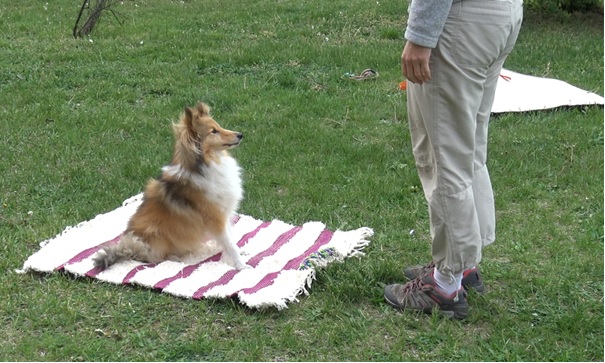Dogs know where their paws end and the world begins
Dogs may have self-awareness just like humans.

Dogs know where their paws end and the world begins, a new study shows, adding our furry companions to a group of animals that, like humans, recognize themselves as distinct entities from their environment.
Called body awareness, this ability is one of the most basic manifestations of self-representation (also known as self-awareness). Humans develop body awareness very early in life: 5-month-old babies can distinguish their own moving legs from a video recording of the same action, for example. This ability then develops into more complex forms of distinguishing oneself from those around them.
Previous research mainly tested species on more complex forms of the ability. For example, one of the most famous tests of self-representation is the "mirror-mark task," in which animals are thought to possess a more advanced form of self-representation, if they can recognize themselves in a mirror.
Related: 7 ways animals are like humans
Perfect Pets: $11.99 at Magazines Direct
"Perfect Pets" is the ultimate guide to the world’s most popular animal companions. Find out what makes dogs man’s best friend, why cats were worshipped in ancient Egypt, plus plenty of other fascinating facts about our furry, feathered — and even some scaly — friends. Inside you’ll learn all about these amazing animals and their unique abilities, plus some top training tips and care guides to help keep your pets happy and healthy.
Great apes, elephants, dolphins, corvid birds and a "constantly growing list" of species pass this test, said senior author Péter Pongrácz, an associate professor in the department of ethology at Eötvös Loránd University in Budapest, Hungary. But dogs had not.
Scientists lost interest in studying species that didn't show these complex forms of self-representation, Pongrácz said. But in the new study, he and his team decided to take a "bottom-up approach" and investigate whether dogs show a lower level of self-representation — one that would be ecologically relevant to them.
"Dogs are intelligent, large-bodied, fast-moving creatures that move in a complex environment," Pongrácz told Live Science. "Therefore, body awareness would be theoretically important for them when negotiating various obstacles, for example."
Get the world’s most fascinating discoveries delivered straight to your inbox.
To test canine body awareness, the researchers recruited 32 dogs and conducted a "body as an obstacle" task. This test had previously been conducted only on elephants and toddlers.

The dogs had to pick up and give an object to their owner while standing on a small mat; however, the object was attached to the mat such that the dog had to get off the mat in order to lift the object (and the mat). In other words, their bodies served as an obstacle to the task at hand, and the dogs needed to deliberately move that obstacle to complete the task. The researchers accounted for other factors, such as fear-inducing conditions, that might otherwise lead the dog to get off the mat or give up on the task, Pongrácz said.
"When dogs pulled on the toy, it also started to lift the mat — thus the dog felt that the mat was jerking under its paws as it was pulling the toy," Pongrácz said. "In this scenario, the dogs quickly left the mat, usually still holding the toy in their mouth; then they gave it to the owner."
The researchers found that the dogs came off the mat more frequently and more quickly when the object was attached to the mat than when the object was attached to the ground, which the researchers used for comparison purposes. This is "the first evidence that dogs may be capable of understanding the connection between their own body and the environment through the feedback effect of their own actions," Pongrácz said. Dogs have also shown other basic components of self-representation, including the ability to recognize their own odor, body-size awareness and episodic memory,or personal memories of specific events, according to the study.
Now, the team hopes to continue investigating self-representation in dogs — for example, by seeing whether other factors influence this ability in individual animals.
The findings were published Thursday (Feb. 18) in the journal Scientific Reports.

Yasemin is a staff writer at Live Science, covering health, neuroscience and biology. Her work has appeared in Scientific American, Science and the San Jose Mercury News. She has a bachelor's degree in biomedical engineering from the University of Connecticut and a graduate certificate in science communication from the University of California, Santa Cruz.

